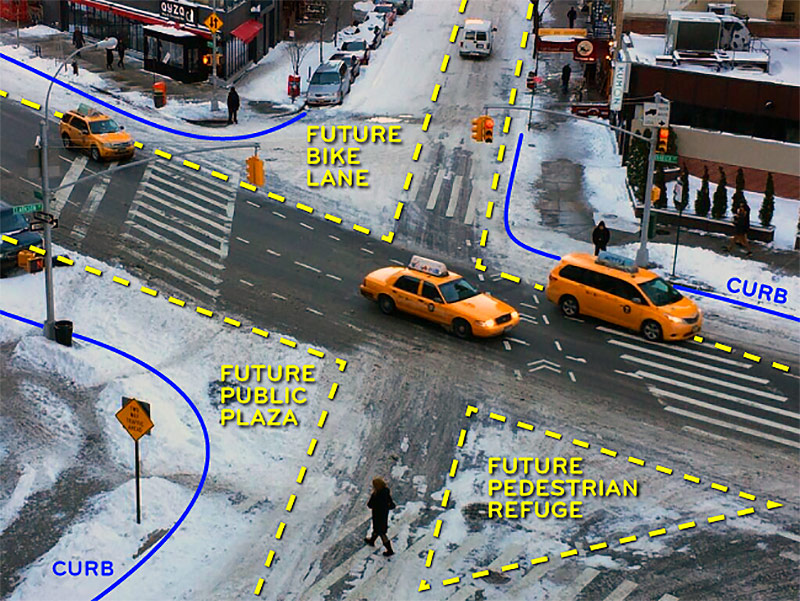
Snow storms are an urbanist’s best friend. As snow builds up along the side of a road and small mountains of sooty snow discolored by car exhaust linger, driving patterns and the actual space needed to accommodate automobiles becomes readily apparent. These snowy remnants are called #sneckdowns, a riff on “snow” paired with the urban planning term “neckdown” which means bumping a sidewalk curb out into the street at intersections to calm traffic and shorten the distance required for a person to cross the street. Louisville has plenty of neckdown examples, such as the streetscape along West Main Street, and this week, #sneckdowns are visible all across the region.
This natural sort of traffic calming provides (at least temporarily) the chance to see how much excess space is devoted to automobiles. According to Transportation Alternatives, a safe streets advocate in New York City that coined the term in 2001:
The wider a street, the safer drivers feel exceeding the speed limit. Streets narrowed by snow have the opposite effect, encouraging drivers to behave. Where normally drivers are jockeying for position, snow banks both sides of the street keep drivers in line and in their lane, demonstrating how narrow the street could be.
We want to see where #sneckdowns in Louisville reveal leftover street space that could be used to create a more pedestrian-friendly city. Take a snapshot of streets in your neighborhood and send them to us at tips@brokensidewalk.com or use this handy form over here. You can also tag @brokensidewalk on Twitter. We’ll post a gallery of reader submissions with the photos you share and even (crudely) render a couple of the best examples to show what an all-weather, pedestrian-friendly streetscape could look like!
Clarence Eckerson Jr. of Streetfilms has been tracking the phenomena in New York City since 2006, finding examples where the paved street can be replaced with wider sidewalks, bumpouts, and new landscaping. Take a look at a couple of his films below:


“Excess”? How exactly is that measured? Just because you can fit a car through it? Keep in mind there are far fewer vehicles out on “snow days” and they are driving much slower.
I am not certain that I agree with your premise for most of the Louisville area. The majority of us do drive to the places that we need go. Slowing us down, increasing drive time, and causing more street congestion may not be viewed as a winning strategy. Downtown, NuLu, a few other neighborhoods are clearly pedestrian areas, but most of our neighborhoods cannot be, They are too spread out for this to be feasible. Most of us will continue to commute to work, go to malls, and shop at big-box stores in our cars. Yes, slow down East Market Street or even Frankfort Avenue, but not Dixie Highway or Shelbyville Road – the reality is that they are not going to become pedestrian areas.
Illustration of excess is measured by excess speeds. Another way to describe this is a road diet, or traffic calming. Traffic calming is safer for pedestrians and motorists. Neighborhoods are going to benefit from this because it is less stressful for those who live and work here, or if they are just driving through.
The temporary (and sometimes prolonged) lane reductions around town reveal excess capacity. In some cases, on some streets, persons driving a car won’t hardly notice the lane that is unavailable. I wish that there were some mechanism in place to measure that “excess” and affect on travel speed. It doesn’t take a snow event to observe those instances.
In the comments above there is some hint of prefernce for the appropriate context for a design solution to equalize access over other modes versus single occupancy vehicle and priority of persons traveling by different modes over varying distances. I would like to have a more detailed conversation on that some day.
Also, curb extensions, (or bulb outs, or bus bulbs, or neck downs) always.
I nominate the five+ way intersection of Winter/ Mary/ Oak and Schiller in the Germantown area for a major intervention. I would like to work with the Patricks on a solution.